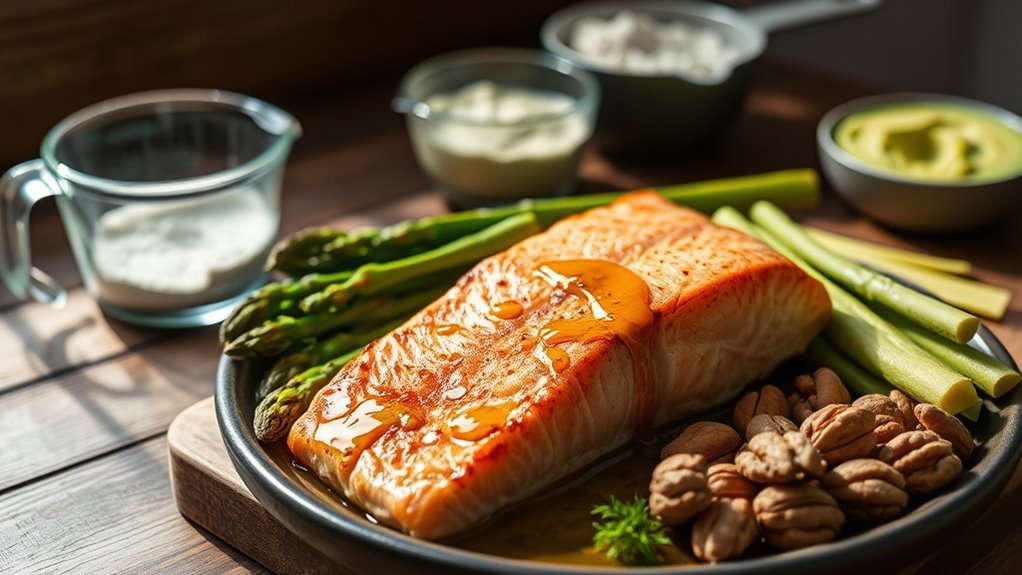Macros in keto refer to the three macronutrients: carbohydrates, proteins, and fats. In a ketogenic diet, you’ll primarily focus on high-fat intake (70-75% of your calories) and limit carbs to about 5-10%. Healthy fats like avocados and olive oil are essential, while protein from sources such as lean meats aids muscle maintenance. Balancing these macros is key to achieving ketosis and optimizing your body’s performance. There’s much more to explore about how to effectively manage your macros.
Understanding Macronutrients: The Basics

Understanding macronutrients is essential for anyone considering a ketogenic diet. There are three primary macronutrient types: carbohydrates, proteins, and fats. In a keto diet, you’ll prioritize fats, aiming for around 70-75% of your daily caloric intake, while limiting carbohydrates to about 5-10%. This balance helps shift your body into a state of ketosis, where it burns fat for energy. Keto food sources rich in healthy fats include avocados, nuts, seeds, and olive oil. Moderate protein intake is also vital, with options like meat, fish, and eggs. By grasping these macronutrient types and their sources, you can make informed choices that free you from conventional dietary constraints, steering you toward your health goals with confidence.
The Role of Carbohydrates in a Ketogenic Diet

While you might think of carbohydrates as a primary energy source, their role in a ketogenic diet is greatly altered due to the diet’s unique macronutrient ratios. In a keto plan, you’ll typically limit carb intake to promote keto adaptation, forcing your body to use fat as a primary energy source instead. Understanding how to manage your carbs can enhance your experience:
- Carb timing: Strategically timing your carbs can optimize energy levels.
- Fiber intake: Prioritize high-fiber food sources to support digestion and maintain overall health.
- Insulin response: Lowering glucose levels can improve insulin sensitivity, beneficial for weight management.
- Carb cycling: Incorporating occasional higher-carb days may help with energy and performance without disrupting ketosis.
This approach allows you to enjoy freedom while maintaining your health goals.
Why Protein Is Essential on Keto

Protein plays an essential role in a ketogenic diet, as it not only supports muscle maintenance but also helps regulate hunger and satiety. By focusing on high-quality protein sources, like lean meats, fish, and plant-based options, you can optimize your protein intake. Timing your protein consumption can enhance protein digestion and muscle recovery, ensuring you achieve a balanced nutrient profile. The benefits of adequate protein extend beyond muscle; it can aid in maintaining energy levels during ketosis. If you struggle to meet your needs through food alone, consider protein supplementation. Ultimately, achieving the right protein balance is vital for both weight management and overall health on your keto journey. Prioritizing protein quality and timing makes all the difference.
The Importance of Fats in Ketosis
Achieving a well-rounded diet on keto means prioritizing fats alongside your protein intake. Healthy fats are essential for your body to efficiently enter and maintain ketosis. By emphasizing fat sources, you’ll support fat metabolism and facilitate fat adaptation, allowing your body to utilize fat as its primary energy source.
Prioritizing healthy fats is key to achieving and maintaining ketosis on a well-rounded keto diet.
- Supports energy levels: Fats provide long-lasting energy.
- Promotes satiety: Fat-rich foods help you feel full longer.
- Enhances nutrient absorption: Dietary fats aid in absorbing fat-soluble vitamins.
- Improves heart health: Healthy fats can contribute to better cardiovascular health.
Balancing your fat intake with quality fat sources enriches your keto experience, ensuring you reap the many fat benefits while enjoying the freedom that this lifestyle offers.
How to Calculate Your Macro Ratios
To calculate your macro ratios effectively, you first need to determine your daily caloric needs based on factors like age, weight, and activity level. Once you’ve established your caloric baseline, you can set specific macro percentage goals, typically focusing on higher fat intake for ideal ketosis. This structured approach will help you tailor your diet to support your health and fitness objectives.
Determine Daily Caloric Needs
While starting on a ketogenic diet, understanding how to determine your daily caloric needs is essential for effectively calculating your macro ratios. You’ll want to evaluate various factors that influence your caloric intake, such as:
- Your basal metabolic rate (BMR)
- Physical activity level
- Goals for body composition (weight loss, maintenance, or gain)
- Overall energy balance
Set Macro Percentage Goals
Once you’ve determined your daily caloric needs, the next step involves setting your macro percentage goals, which will guide your nutrient intake on a ketogenic diet. Typically, a keto diet consists of about 70-75% fats, 20-25% protein, and 5-10% carbohydrates. These macro percentages are essential for achieving and maintaining ketosis, where your body burns fat for fuel instead of carbs. To calculate your individual ratios, consider factors like your activity level, age, and weight loss goals. Adjust these percentages as needed, ensuring they align with your personal preferences and lifestyle. Remember, setting goals isn’t just about numbers; it’s about finding a balance that allows you to enjoy your meals while staying on track with your health objectives.
Tracking Your Macros: Tools and Tips
How can you effectively track your macros on a keto diet? Accurate macro tracking is essential for maintaining ketosis and achieving your health goals. Using the right macro tools can simplify this process and help you stay on track. Here are some tips to enhance your tracking experience:
- Utilize mobile apps for easy logging and real-time feedback.
- Weigh your food for precise measurements and portion control.
- Keep a food diary to identify patterns and adjustments.
- Join online communities for support and shared resources.
Common Mistakes in Macro Tracking
Even with the right tools to track your macros on a keto diet, mistakes can easily occur that hinder your progress. Here are some common tracking errors to watch for:
| Mistake | Description | Impact |
|---|---|---|
| Portion Size Misconceptions | Underestimating or overestimating servings | Skewed macro ratios |
| Food Label Confusion | Misreading nutritional content | Incorrect carb intake |
| Meal Timing Issues | Ignoring ideal timing for meals | Affects ketosis |
| Inconsistent Logging Habits | Failing to log all meals consistently | Inaccurate tracking |
| Neglecting Hidden Carbs | Overlooking carbs in sauces or condiments | Unplanned carb intake |
Adjusting Macros for Weight Loss and Maintenance
As you progress on your keto journey, adjusting your macros becomes essential for achieving both weight loss and maintenance goals. Tailoring your macronutrient ratios can optimize your body’s fat-burning capabilities while ensuring you feel satisfied. Here are some effective weight loss strategies and maintenance tips to take into account:
- Gradually decrease carb intake to enhance ketosis.
- Monitor protein levels to prevent muscle loss during weight loss.
- Adjust fats to maintain energy levels and satiety.
- Regularly reassess your caloric needs as your weight changes.
The Benefits of Macro Awareness in Keto
While many people focus solely on the carbohydrate content of their meals, being aware of your overall macronutrient distribution is essential for maximizing the benefits of a ketogenic diet. Practicing macro mindfulness allows you to tailor your intake of fats, proteins, and carbs to suit your specific health goals, whether it’s weight loss or muscle gain. This awareness fosters keto flexibility, enabling you to enjoy a wider variety of foods while still staying in ketosis. When you understand how different macros affect your body, you gain the freedom to make informed choices that align with your lifestyle. Ultimately, embracing macro awareness can enhance your overall experience on the ketogenic journey, leading to sustainable results and a healthier relationship with food.


